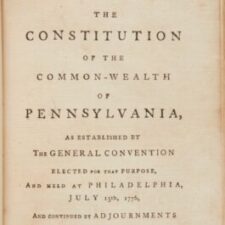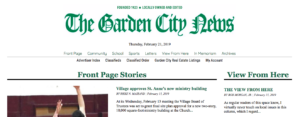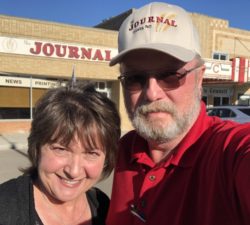 Pay close attention to reporting on public notice issues and you may begin to observe that some papers have adopted certain rhetorical habits that tend to undermine the goal of preserving newspaper notice. They’re mostly innocent mistakes made by people who are unaware that what they’re doing may be counterproductive. But it’s fair to say that if those habits could be eliminated it might enhance the policy environment for maintaining newspaper notice.
Pay close attention to reporting on public notice issues and you may begin to observe that some papers have adopted certain rhetorical habits that tend to undermine the goal of preserving newspaper notice. They’re mostly innocent mistakes made by people who are unaware that what they’re doing may be counterproductive. But it’s fair to say that if those habits could be eliminated it might enhance the policy environment for maintaining newspaper notice.
Pennsylvania reporter wins public notice reporting award
 It was bound to happen again.
It was bound to happen again.
Jim Lockwood (pictured on left), a reporter for the Times-Tribune in Scranton, Pa., has been named the 2023 winner of PNRC’s Michael Kramer Public Notice Journalism Award.
The award was announced yesterday as part of the National Newspaper Association Foundation’s 2023 Better Newspaper Editorial Contest. Lockwood previously won the prize in 2015 and came in second place, or tied for second, every year since then except 2022.
The award is given annually to the best reporting that uses public notice as a primary source of information.
The newspaper industry’s challenge
 A recent column on the nonprofit news website the Pennsylvania Capital-Star argues that Pennsylvania voters should receive more notice about proposed amendments to the state’s Constitution advanced by Republican lawmakers this year. The column’s author, Patrick Beaty, believes the notice requirements set by the Constitution are insufficient.
A recent column on the nonprofit news website the Pennsylvania Capital-Star argues that Pennsylvania voters should receive more notice about proposed amendments to the state’s Constitution advanced by Republican lawmakers this year. The column’s author, Patrick Beaty, believes the notice requirements set by the Constitution are insufficient.
We have no position on the substance of the amendments or on Beaty’s call for more transparency surrounding the amendment process.
Nevertheless, his column offers an excellent illustration of a major challenge facing the newspaper industry: To reframe the debate around public notice by helping people understand that notices published in newspapers are also published on newspaper websites.
PNRC contest winners’ concerns often disregarded by officials
Take Crosby, North Dakota, population 1,300, for instance. It’s located in the upper northwest corner of the state, approximately 35 miles east of Montana and six miles south of the Canadian border. Many folks there have an extraordinary interest in the public notices published in the local paper, the Journal.
“Sometimes we get calls from people aware of something happening in town and wondering why a notice about it wasn’t published in the paper,” says Cecile Wehrman (pictured on left in photo above), the Journal’s editor and publisher.
City pulls notices after critical coverage
 A New York Times story reports on a move by the Garden City, N.Y. village board to take public notices out of a local newspaper and start running them in a smaller competitor.
A New York Times story reports on a move by the Garden City, N.Y. village board to take public notices out of a local newspaper and start running them in a smaller competitor.
It’s the latest attempt by government officials to use economic pressure to try to sway coverage.
Meg Morgan Norris, editor and publisher of the 8,300-circulation Garden City News, has been critical of the village board’s handling of the redevelopment of a local landmark.
In addition to cutting the notices, the village board also has threatened to stop sending news items like calendar listings and senior columns to the News.
Jim Lockwood Elevates the Art of Public Notice Journalism
Examining the public notice display in newspapers, their tombstone layout and dry legalese may not appear to be riveting journalism. But scratch beneath the surface and you may find a treasure trove of great stories.
Just ask Jim Lockwood, a reporter at the Scranton (Pa.) Times-Tribune, who has won numerous awards for stories gleaned from perusing the public notices in his own newspaper, a practice he started early in his career as a reporter in New Jersey. Public notice advertisements are Lockwood’s go-to resource for everyday reporting.
Michigan Reporter Wins Public Notice Journalism Award
 Garret Ellison, a reporter for MLive and The Grand Rapids Press, today was named winner of PNRC’s 2018 Public Notice Journalism Award. Ellison won for a series of stories about an application submitted to the Michigan Department of Environmental Quality (MDEQ) by Nestle Waters North America to pump more groundwater from a local well. He is the first reporter in the history of the PNRC contest to be awarded for a story revealing the inadequacy of government website notice.
Garret Ellison, a reporter for MLive and The Grand Rapids Press, today was named winner of PNRC’s 2018 Public Notice Journalism Award. Ellison won for a series of stories about an application submitted to the Michigan Department of Environmental Quality (MDEQ) by Nestle Waters North America to pump more groundwater from a local well. He is the first reporter in the history of the PNRC contest to be awarded for a story revealing the inadequacy of government website notice.
Ellison will receive a $500 award and a trip to Washington, D.C., where he will be honored at a special March 15 dinner at the National Press Club.
More Newspapers Should Do This
 The Aug. 30 issue of the (Scranton, Pa.) Times-Tribune featured a story by public-notice reporting wiz Jim Lockwood about the annual “upset sale” of tax delinquent properties in Lackawanna County. The story was prompted by a six-page notice in the paper listing 1,883 properties for which delinquent taxes are owed to the county.
The Aug. 30 issue of the (Scranton, Pa.) Times-Tribune featured a story by public-notice reporting wiz Jim Lockwood about the annual “upset sale” of tax delinquent properties in Lackawanna County. The story was prompted by a six-page notice in the paper listing 1,883 properties for which delinquent taxes are owed to the county.
The story includes comments from the public official responsible for placing the notice. Here’s what he told Lockwood, who won PNRC’s Public Notice Journalism Award in 2015 and came in second in last year’s contest.
Letter: Public Notice Might as Well Have Been in Swahili
The following is a letter to the editor of the Longmont (Colo.) Times-Call published on the newspaper’s website on March 9.
To the Editor:
What is public notice 02-2017-14 published on March 3, 2017, about? Vacation? What is a PUD? Where is Blue Vista? How can anyone be expected to make comments or decisions based on a map that is printed so small that it is unreadable — it could have been in Swahili for all it is worth.
South Dakotan Produces News Series From Public Notices
 Public notice isn’t a big deal to the nine South Dakota lawmakers who introduced House Bill 1167, a piece of legislation that would have moved municipal notices from newspapers to websites in many S.D. cities, if it hadn’t been killed in committee. To Brian Hunhoff (photo on left), public notice is absolutely vital.
Public notice isn’t a big deal to the nine South Dakota lawmakers who introduced House Bill 1167, a piece of legislation that would have moved municipal notices from newspapers to websites in many S.D. cities, if it hadn’t been killed in committee. To Brian Hunhoff (photo on left), public notice is absolutely vital.
Hunhoff, a contributing editor at the Yankton County Observer, has been demonstrating just how important it is with “In a Minutes Notice,” a new weekly column based on news culled from meeting minutes and legal notices published in the Observer and other newspapers in the Mount Rushmore state.
“I’ve been meaning to do this series for a long time, but could never seem to find the time,” says Hunhoff. “Then I read the (PNRC) story in the National Newspaper Association’s PubAux about all the public notice battles taking place around the country and decided it would be a good year to finally make time and get it done.”
Hunhoff has already published eight public notice-based columns (see PDFs linked below) and plans to write at least six more in the coming weeks. They include deep dives on particular subjects, like the salaries of local public officials or the frequency and length of their executive sessions. He has also reviewed meeting minutes and budgets from 12 similar-size cities and counties to learn how Yankton County and City of Yankton rank in comparison.
Hunhoff admits the project has required a great deal of research. He has spent many hours studying public notices in Observer bound volumes going back 40 years to uncover trends relating to tax-exempt properties, delinquent taxpayer lists, and highway department spending.
His commitment to the project is particularly remarkable when one considers that newspapering is no longer Hunhoff’s primary job. He was in the newspaper business full-time for 23 years until he sold the Observer in 2002. Current publishers are twin sisters Kathy Church and Kristy Wyland.
Hunhoff has been a part-time contributor to the 40-year-old weekly since selling it. His full-time job now is Yankton County Register of Deeds, where he takes pride in operating the best document archive — he calls it a “library” — in the state. He saves his public notice reporting for evenings and weekends.
Hunhoff says research for the public notice column inspires ideas for editorials. He has written four related opinion pieces for the paper since the first “In a Minutes Notice” story was published in mid-February.
His real goal, though, is to highlight the value of public notices in newspapers and help Observer readers understand their importance. He knows fewer people would read them if they were moved to the Internet — “out of sight, out of mind” he says — and that concerns him.
Hunhoff has used photos of local officials, town halls, a snowplow and a fire truck to illustrate the articles. Over 90 percent of the content is distilled from public notices. “It’s not a lot of fancy writing – just a straightforward presentation of facts gleaned from minutes and other notices,” he said. “I study numbers in a particular area until I find a newsworthy trend. Giving these stories a lead with a news hook has been the key to pulling readers in.”
“Reader response to the stories has been very good,” he added. “People seem to find them interesting and that’s the goal: To help folks understand how much important information is available in public notices in newspapers.”



